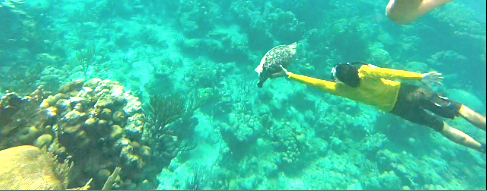It was another beautiful and sunny day in Culebra. We woke up around 7:30 this morning to be on the road by 8:00 and in the water by 9:00. The plan was to meet up at the gas station in town, fill up both boats with gas, and set out to the Luis Peña Marine Reserve. Unlike yesterday, the goal was to catch hawksbill turtles by hand. Although the method of catching the turtles was different, we collected the same types of data from the hawksbills. We split up into two groups, and each group snorkeled along a specific transect of the coral reef, surveying a cross section of the reef. For each transect, we swam parallel to the shore and tried to stay in a straight line with each other. During the first transect, one group didn’t spot any turtles, but the other caught two green turtles and one hawksbill. We took carapace measurements, weight, and checked for tags. After a nice lunch and slather-yourself-with-sunscreen break, we switched transects and set out for another round of snorkeling. One group caught one hawksbill and the other group saw one hawksbill but it swam into deeper water before they could capture it.
Both hawksbills were noticeably darker in color than the green turtles we have been used to seeing. We also noticed that they were larger than the relatively small green turtles that we caught on the reef, which may be a local trend or may have simply happened by chance. Hawksbills have overlapping scutes (that look a bit like roof shingles), while green turtles have more flattened scutes. The coral reef habitat that we went to today was very different from Manglar, mainly because hawksbills feed on sponges that can be found throughout reserve. Even though sponges are protected with glass spicules, hawksbills are able to successfully process them. Hawksbill turtles play an important role in the ecosystem by foraging on sponges. Sponges are able to out compete corals for space on the sea floor, so hawksbill foraging on sponges increases coral reef diversity by creating space for other organisms and corals.
After snorkeling for two hours total and being out on the boats for nearly four hours, we split up into two groups and headed home. We were given the option of taking a bumpy boat ride back to the house, circumnavigating the island in the warm, beautiful sunshine and socializing with friends or…going straight back to the gas station/missing out on a lot of fun and driving back to the house. Even though it was a tough decision, Tim and I immediately chose the scenic, fun route.
Once we made it back to the house, everyone got cleaned up and had some down time before dinner. After dinner we got together and had two lectures; one by Cristian and another by Nilda. Cristian gave his lecture primarily in Spanish and Nilda translated. We learned a lot about his research with leatherback turtles. Cristian’s lecture began with a general overview of conservation and the importance of leatherbacks in Puerto Rico. He highlighted the fact that they are listed as critically endangered on the IUCN Red List and there are numerous threats to their survival, both globally and locally. Cristian also taught us about two possibilities regarding nesting populations – there may be one population that inhabits different areas, or there are several different nesting populations. Further exploration of these possibilities will be very helpful when making management decisions to protect and conserve leatherbacks.
Nilda lectured about conservation and touched upon a variety of research projects that she has been involved in, including work with brown pelicans and fisheries. Nilda’s presentation was useful because she gave us advice that will be helpful for the rest of our lives as biologists or scientists in general. For example, the basics of conducting research effectively include collecting information about the site, determining whether or not the methodology already exists or should be developed, working with clear objectives, and understanding your team members for maximum efficiency in the field.
Overall, we learned a lot today both in the classroom-kitchen and in the field. We are well-rested and ready for another exciting day tomorrow!
Check out this link to watch our video of hawksbill diving day!: medium



